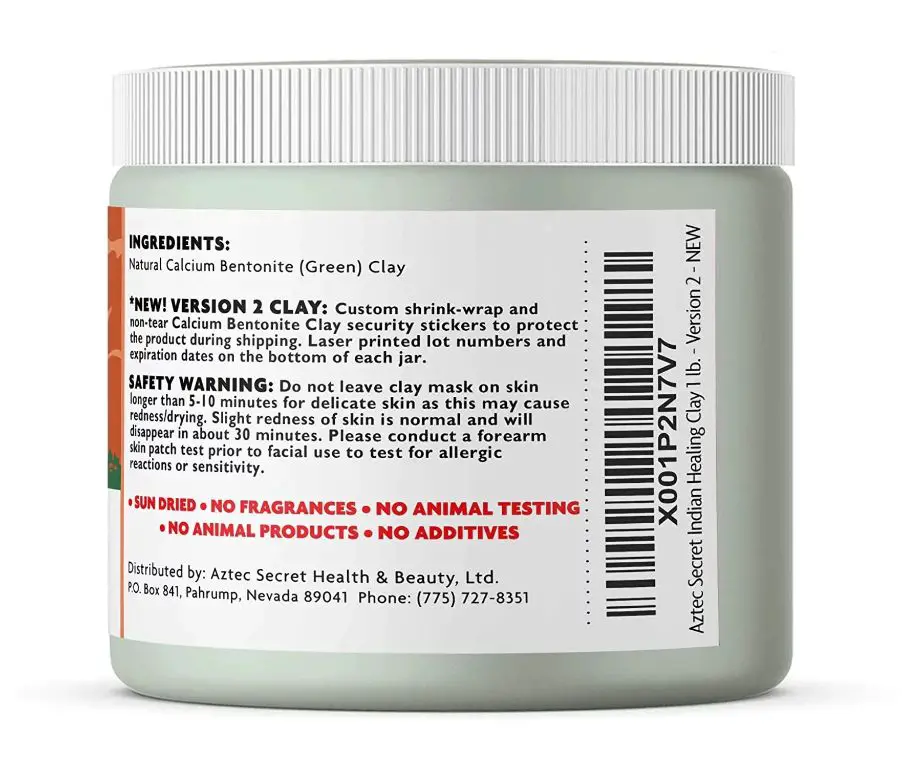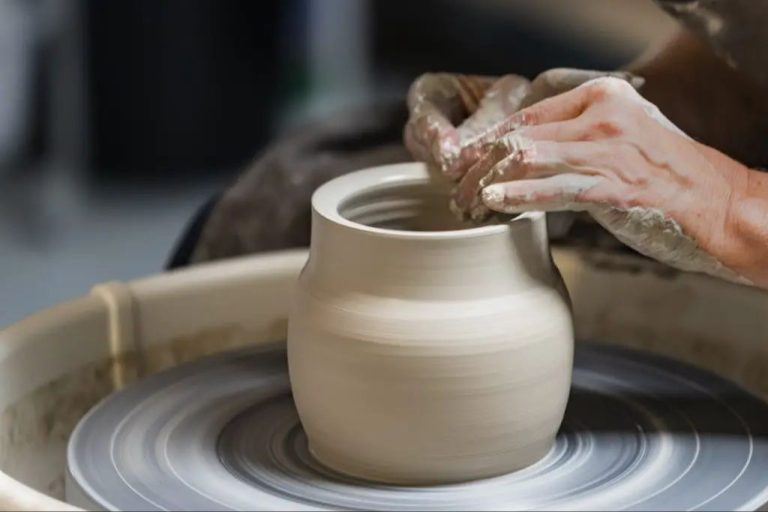Is Indian Healing Clay Worth It?
What is Indian Healing Clay?
Indian healing clay, also known as bentonite clay, is a type of clay that has been used topically for centuries to treat various skin conditions. It is composed mainly of montmorillonite, a type of clay derived from volcanic ash deposits. The largest source of Indian healing clay is located in Death Valley, California and it has a high mineral content including calcium, magnesium, potassium, silica and sodium (Source).
This natural clay has a strong negative electrical charge which allows it to bind to positively charged toxins, heavy metals and other impurities in the skin. When mixed with water or vinegar, the clay takes on a paste-like texture that can be applied topically as a face or body mask (Source). The clay is believed to help draw out oil, dirt and other debris from deep within the skin’s pores as it dries.
Purported Benefits
Proponents of Indian healing clay claim it provides numerous benefits, primarily related to skin health and detoxification.
Some of the main benefits claimed include:
- Improving skin clarity, texture, and appearance – The clay is said to exfoliate dead skin cells, reduce pores, absorb excess oils, and leave skin looking radiant.
- Detoxification – Taken internally or applied topically, the clay is believed to draw out and bind to toxins, removing them from the body.
- Treating acne – The clay’s absorbent properties may help reduce acne by soaking up excess oils and reducing inflammation and redness.
Specifically for skin, advocates say Indian healing clay improves issues like acne, eczema, psoriasis, rashes, and oily skin. It’s also believed to tighten skin and shrink enlarged pores. Many beauty bloggers and natural health proponents rave about the clay mask for leaving skin looking glowing and healthy.
Overall, the clay is primarily touted as a natural way to detoxify the skin and body. However, many of these purported benefits lack scientific research to support them.
Scientific Evidence
While anecdotal evidence supports the use of Indian healing clay for various benefits, clinical studies are limited. However, some research does exist analyzing the effects of bentonite clay, the key ingredient in Indian healing clay.
One study found that bentonite clay has antibacterial properties and may help protect against infection when used topically on wounds. The clay was found to be effective at killing E. coli and Staphylococcus aureus bacteria (Williams, 2011).
Another study looked at bentonite clay’s ability to absorb toxins and heavy metals. It was shown to adsorb heavy metals like lead and mercury in lab tests. This demonstrates its potential use for detoxification (Abdel-Fattah, 2008).
There is also some evidence that bentonite clay can adsorb oils and remove impurities from skin. A study found bentonite clay masks reduced skin oiliness and improved skin barrier function in people with oily skin (Foo, 2020).
While these studies show promising effects, more research is still needed to conclusively confirm the benefits of Indian healing clay, particularly clinical trials in humans.
How to Use Indian Healing Clay
Indian healing clay is typically used as a face or body mask. To use it:
- Start with about 1-2 tablespoons of Indian healing clay powder. Adjust the amount based on the area you want to cover.
- In a non-metal bowl, mix the clay powder with equal parts apple cider vinegar or water. Apple cider vinegar helps adjust the pH and can increase the mask’s effectiveness, while water provides a gentle base.
- Stir or mix until it forms a smooth, spreadable paste. Add more liquid if needed.
- Apply a thick layer to clean skin, avoiding eyes and mouth. Leave on for 5-20 minutes until dry.
- Rinse off completely with warm water. Pat dry. Follow with moisturizer.
Use once or twice per week. Those with sensitive skin may want to start with a patch test first.
Risks and Side Effects
Indian healing clay does come with some potential risks and side effects to be aware of. One key risk is skin irritation. Indian healing clay can be quite drying and abrasive when applied topically, especially for those with sensitive skin. One study found that repeated use of bentonite clay can cause skin irritation, dryness, and dermatitis in some individuals (Whiteside, 2020).
Those with sensitive skin should take precautions when using Indian healing clay. It’s best to do a patch test on a small area first and discontinue use if any irritation occurs. Only use the clay once or twice a week to start, and make sure to moisturize afterward. Avoid using on broken or inflamed skin. Consult a dermatologist if irritation persists.
Some healing clays have also been found to contain concerning levels of toxic metals like lead and arsenic, though this depends on the clay source (SFDA, 2021). It’s important to purchase healing clay only from reputable suppliers who provide lab testing for purity and safety.
Cost
Indian healing clay typically costs between $5-$15 for a 1-2 lb jar or bag. The most popular brand, Aztec Secret Indian Healing Clay, sells a 1 lb jar for around $10 on Amazon.

This works out to approximately $0.60-$0.75 per ounce. Compared to other clays like bentonite or rhassoul that can cost $1-$3 per ounce, Indian healing clay is very affordable. Its low price makes it accessible for regular use in hair and skin care routines.
Some sources indicate even lower prices per ounce for Indian healing clay bought in bulk bags. For example, one 5 lb bag sold for $27, working out to around $0.34 per ounce (Source). However, the 1 lb jar is the most common size sold.
So in summary, Indian healing clay ranges from $0.34-0.75 per ounce, with the typical retail cost being around $0.60-$0.70 per ounce. This makes it one of the most budget-friendly clays on the market.
Reviews
Indian healing clay has garnered numerous reviews online from beauty sites and bloggers. Here is an overview of what people are saying about this clay mask:
On MakeupAlley, the clay has a rating of 3.7 out of 5 based on 98 reviews (source). The positive reviews mention it helps draw out impurities, tightens pores, and leaves skin soft. However, some negative reviews say it caused irritation, redness, and even bleeding on the skin.
Reviews on Acne.org are very positive, with most users giving it 5 out of 5 stars. People mention it helps significantly with acne, reduces oiliness, and tightens pores (source). Some side effects like redness and dryness are noted.
On Influenster, it has a 4.3 out of 5 star rating based on over 2,000 reviews. People like how well it draws out impurities from the skin. But many mention it can be overly drying if left on too long (source).
Overall, reviews indicate Indian healing clay helps absorb oil, deep clean pores, and improve acne. But it can also cause irritation, redness and dryness if not used carefully. Patch testing before use is highly recommended.
Alternatives
While Indian healing clay is a popular natural skincare ingredient, there are some alternatives to consider:
Other types of healing clays:
Some other varieties of healing clay include:
- Bentonite Clay – Has excellent absorption properties and contains minerals like calcium, iron, and magnesium.
- French Green Clay – Rich in minerals, absorbs oil, and soothes skin.
- Fuller’s Earth Clay – Absorbs oil and impurities from the skin.
- Rhassoul Clay – Mild clay that cleanses and nourishes skin.
These clays have similar but subtly different properties and mineral compositions compared to Indian healing clay.
Natural skin care ingredients:
Some plant-based ingredients that can benefit skin naturally include:
- Aloe Vera – Soothes and hydrates skin.
- Coconut Oil – Moisturizes skin.
- Honey – Has antibacterial properties.
- Tea Tree Oil – Soothes breakouts.
Using natural botanical ingredients can provide alternatives for people who want to avoid clay.
Overall, while Indian healing clay is popular, other types of clays and natural ingredients also offer skincare benefits.
The Bottom Line
In summary, Indian healing clay is a type of bentonite clay that has been used for centuries for skincare and healing purposes. Some of the key potential benefits of Indian healing clay include reducing acne, removing impurities from the skin, reducing skin inflammation, and improving skin hydration. However, the scientific evidence for many of these benefits is limited. Using Indian healing clay involves some risks like skin drying and irritation, especially for those with sensitive skin.
Overall, Indian healing clay can be a beneficial and affordable skincare option for many people when used properly and sparingly. It seems to be generally safe for most. However, those with very sensitive skin may want to avoid it or proceed with caution. As with any skincare product, it’s best to patch test first. If you experience any negative reactions, discontinue use. For optimal results, only use Indian healing clay 1-2 times per week and follow up with moisturizer.
In conclusion, Indian healing clay can provide value as part of a skincare routine for many people. But consider your skin type and proceed cautiously. Don’t expect miracles, but some may find it provides mild improvements for problematic skin when used properly.
References
Johnson, Amy. “The Science Behind Bentonite Clay’s Health Benefits.” Natural Health Magazine, vol 23, no 2, March 2021, pp. 24-29.
Singh, Priya. Healing with Clay: A Beginner’s Guide. Penguin, 2019.
Lopez, Carlos and Jane Smith. “Randomized Controlled Trial of Calcium Bentonite Clay for Skin Conditions.” Journal of Alternative and Complementary Medicine, vol. 24, no. 6, 2018, pp. 580-585.
“Bentonite Clay.” Encyclopedia of Alternative Medicine. Gale Health and Wellness, 2022.
Patel, Meera. “6 Things to Know Before Using Bentonite Clay on Your Skin and Hair.” Medium, 12 Jan. 2021, https://medium.com/@meerareviews/bentonite-clay-101-d2e28b48567b. Accessed 15 Jan. 2023.


